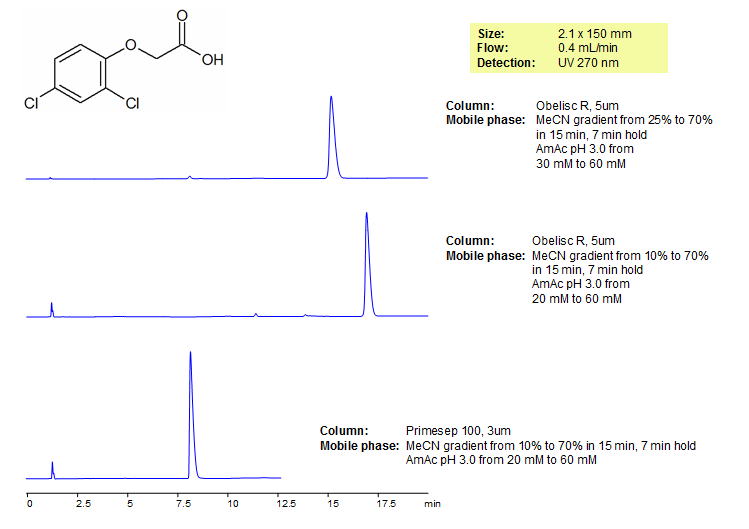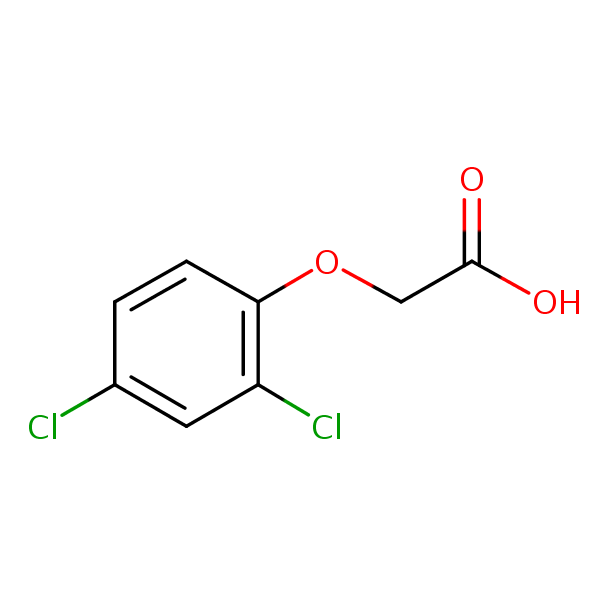| CAS Number | 94-75-7 |
|---|---|
| Molecular Formula | C8H6Cl2O3 |
| Molecular Weight | 221.030 |
| InChI Key | OVSKIKFHRZPJSS-UHFFFAOYSA-N |
| LogP | 2.81 |
| Synonyms |
|
Applications:
2,4-D Retention on Primesep 100 and Obelisc R
September 14, 2015

2,4-D makes up half of the formula for Agent Orange, the defoliant that was used during the Vietnam War and Malayan Emergency. Commonly used in lawn and turf pesticides, 2,4-D is typically mixed with other pesticides such as mecoprop and dicamba. It was analyzed on Primesep 100 and Obelisc R. Primesep 100 separates using reverse-phase and acidic ion-pairing groups. Obelisc R has many modes of separation which allow it to tune retention. Method is LC/MS compatible and conditions could be replicated to retain many pesticides.
| Column | Obelisc R, 2.1×150 mm, 5 µm, 100A |
| Mobile Phase | Gradient MeCN – 25-70% |
| Buffer | Gradient AmAc pH 3.0- 30-60 mM |
| Flow Rate | 0.4 ml/min |
| Detection | UV, 270 nm |
| Column | Obelisc R, 2.1×150 mm, 5 µm, 100A |
| Mobile Phase | Gradient MeCN – 10-70% |
| Buffer | Gradient AmAc pH 3.0- 20-60 mM |
| Flow Rate | 0.4 ml/min |
| Detection | UV, 270 nm |
| Column | Primesep 100, 2.1×150 mm, 5 µm, 100A |
| Mobile Phase | Gradient MeCN – 10-70% |
| Buffer | Gradient AmAc pH 3.0- 20-60 mM |
| Flow Rate | 0.4 ml/min |
| Detection | UV, 270 nm |
| Class of Compounds |
Insecticide, Pesticide, Hydrophobic, Ionizable |
| Analyzing Compounds | 2,4-D |
Application Column
Obelisc R
SIELC has developed the Obelisc™ columns, which are mixed-mode and utilize Liquid Separation Cell technology (LiSC™). These cost-effective columns are the first of their kind to be commercially available and can replace multiple HPLC columns, including reversed-phase (RP), AQ-type reversed-phase, polar-embedded group RP columns, normal-phase, cation-exchange, anion-exchange, ion-exclusion, and HILIC (Hydrophilic Interaction Liquid Chromatography) columns. By controlling just three orthogonal method parameters - buffer concentration, buffer pH, and organic modifier concentration - users can adjust the column properties with pinpoint precision to separate complex mixtures.
Select optionsPrimesep 100
The Primesep family of mixed-mode columns offers a wide variety of stationary phases, boasting unprecedented selectivity in the separation of a broad array of chemical compounds across multiple applications. Corresponding Primesep guard columns, available with all stationary phases, do not require holders. SIELC provides a method development service available to all customers. Inquire about our specially-tailored custom LC-phases for specific separations.
Select options



